Tackling the growing issue of waste is a paramount concern for scientists, industry, and governments worldwide. By reducing and valorizing waste streams, the industry can achieve the aims of the circular economy. Analyzing the application of green economy methods and strategies to materials science to achieve zero waste is the focus of a new study published in Progress in Natural Sciences: Materials International.

Study: Green economy and waste management: An inevitable plan for materials science. Image Credit: Lambertt/Shutterstock.com
Achieving Zero Waste
Human activity is causing an alarming amount of damage to the natural environment and, consequently, growing economic and social issues as the world deals with the effects of climate change and waste. Rapid urbanization, industrialization, and population growth have led to 2.12 billion tons of waste being disposed of annually worldwide.
According to estimates by the World Bank, waste generation is predicted to rise by 70% to 3.40 billion tons by 2050 unless swift action is taken.
Achieving zero waste is of central concern for global governments and industries. A major issue is plastic waste, with most products currently designed to be single-use. In Europe alone, only 32% of the 29.1 million metric tons of plastic waste recovered in 2018 was recycled, with the rest ending up in landfills or the oceans. Once the plastic is in the environment, it can take centuries to degrade and the impact on fragile ecosystems and the food chain are well-documented.
Another major challenge is the growing amount of electrical and electronic waste. The increasing demand for electronic products has caused an almost exponential growth in waste materials, and the complex construction of electronic and electrical products and multiple materials makes recycling and reuse of them difficult. Materials such as copper, silicon, lithium, and plastic and ceramic components are valuable but are typically lost in the disposal process, leading to the unnecessary exploitation of virgin resources. In 2019, only 17.4% of e-waste was recycled, with huge amounts of valuable e-waste ending up in landfills.
Furthermore, the amount of waste from medical products such as gloves and facemasks has increased by 350% since the beginning of the COVID-19 pandemic according to a report by the Waste Agency of California. Single-use swabs and Covid testing kits have added to the problem. Additionally, untreated medical waste can cause environmental and health damage, releasing dangerous toxic, cytotoxic and radioactive chemicals into the environment.
Achieving zero waste will require changes to production methods, government regulations, consumer patterns, and investment in sustainable green technology, infrastructure, and methods. The way forward will be complex and require innovative ways of thinking and commitment from all sectors and levels of society.
The Study
The aims of the circular economy are to recycle, reclaim, and reuse waste materials for value-added commercial products. The new study published online in Progress in Natural Science: Materials International has explored the application of circular economy methods and green technologies to materials science.
The study investigates current perspectives and research in this area as well as recent progress worldwide to achieve zero waste and move the world toward a more sustainable future. Areas covered include green vs. nonbiodegradable plastics, electronics and electrical waste, medical waste, green chemistry, and strategies for achieving circularity in the battery industry.
More from AZoM: An Overview of Microwave Nondestructive Testing
Current progress by environmental agencies in producing guidelines to tackle waste streams are discussed in the study, such as the WHO and U.S. Environmental Protection Agency’s guidelines to tackle waste such as unauthorized medical waste. The problem with wealthier nations sending waste such as electronics and plastics to developing countries is also discussed.
Furthermore, the development of sustainable products and the reuse of waste streams, turning them into valuable products that reduce the amount of waste in the environment, and the exploitation of non-renewable resources is discussed in the study. Green materials with comparable performance to conventional materials are explored.
Aside from environmental damage, the accumulation of waste presents several social and human health issues. Clearly, sustainability is the only way forward to mitigate the impact of human society, and implementing a circular economy and developing green technology will help safeguard future generations.
Finally, the authors have discussed the issue in terms of the COVID-19 pandemic. Whilst in the early months of the pandemic, there was news coverage of improved air and water quality caused by a slowing of human activity (for example, vastly reduced transport emissions) the amount of waste from medical equipment, PPE, and single-use plastic has increased dramatically.
As the authors have stated, the time to act is now, as the problems with achieving true sustainability require swift action from all sectors of society. Materials science can play a key role in achieving this.
Further Reading
Nandy, S, Fortunato, E & Martins, R (2022) Green economy and waste management: An inevitable plan for materials science [online] Progress in Natural Science: Materials Edition 31(6) | sciencedirect.com. Available at: https://www.sciencedirect.com/science/article/pii/S1002007122000016
Disclaimer: The views expressed here are those of the author expressed in their private capacity and do not necessarily represent the views of AZoM.com Limited T/A AZoNetwork the owner and operator of this website. This disclaimer forms part of the Terms and conditions of use of this website.